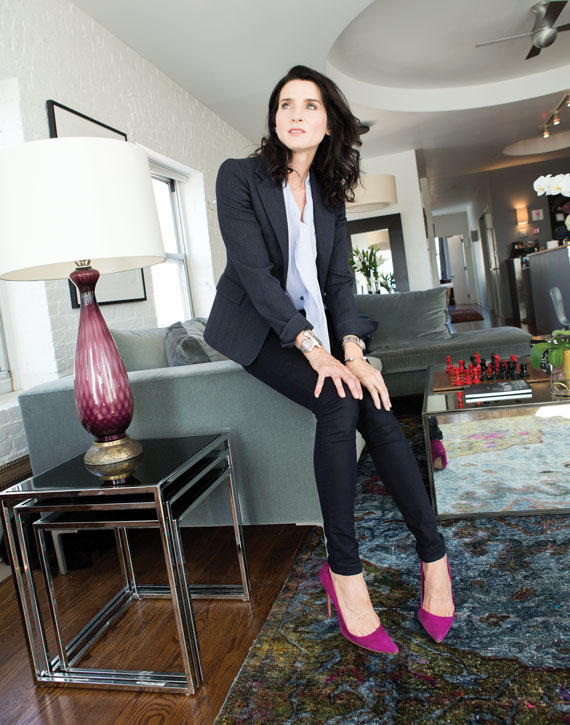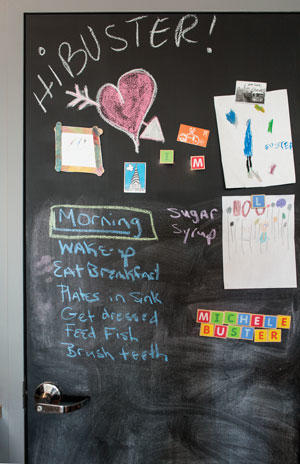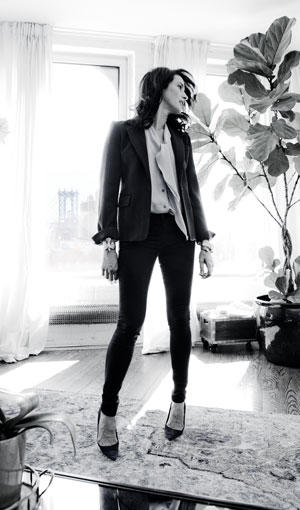Trending
Keeping her cool
Actress Michele Hicks lends her indie style to roles in ‘Public Morals’ and ‘Mr. Robot’

On a late night this summer, model-turned-actress Michele Hicks, 42, died. She was strangled slowly; her killer (and seducer) straddling her. It happened on a Manhattan rooftop, with the Chrysler Building shining in the background. With the killer’s hands around her neck, she struggled, writhing in her blue dress and kicking off her heels, until she lost consciousness.
It was Hicks first on-camera death scene for television.
“It’s funny, I had a few friends call me up and say, ‘That was really hard to watch, Michele!’ They were really disturbed by it. I didn’t know, because I was in it,” Hicks tells LLNYC at the dining room table of her Lower East Side penthouse that she shares with her husband, actor Jonny Lee Miller, and their six-year-old son, Buster. The dramatic scene that aired in August was the final act for her character Sharon Knowles, who was killed off on the USA Networks’ hit cyber-thriller, “Mr. Robot.”
“It was intense,” she says, leaning in to describe the filming. “It was a really late night, around one o’clock in the morning, on a roof. And there where so many different angles. I just thought it was a long shoot because of all the different angles and coverage, but I guess once you see it, it was really drawn out.”
“I’m glad it had that much of an effect. I did well, I guess,” she adds.
It’s strange to say, but Hicks wears death well. That is to say, beneath her lightly effervescent voice and frequent smirks, she has fiery eyes and a knack for playing macabre roles in cult films like “Twin Falls Idaho” and “Mulholland Drive.” “I love David Lynch’s work. He’s the nicest guy,” Hicks says.
 Most recently, she was seen as Kay O’Bannon on Edward Burns’ “Public Morals,” a gritty police drama focused on corrupt cops, prostitution, gambling and violence in 1960s Hell’s Kitchen that premiered this summer. The cast is waiting for the second season to get picked up by TNT.
Most recently, she was seen as Kay O’Bannon on Edward Burns’ “Public Morals,” a gritty police drama focused on corrupt cops, prostitution, gambling and violence in 1960s Hell’s Kitchen that premiered this summer. The cast is waiting for the second season to get picked up by TNT.
“[‘Public Morals’] has really great style. It was really great to shoot old New York in New York,” Hicks says. “The 1960s period is very fun. And everyone has these really thick New York accents, which is fun to work with.”
“Public Morals” isn’t Hicks’ crime drama debut by a long shot. In fact, Hicks has appeared in a long list of contemporary hard-boiled cop shows, including “Blue Bloods,” “The Mentalist,” “Heist,” “Cold Case,” “CSI: NY,” “Law & Order: Special Victims Unit,” “Law & Order: Criminal Intent” and five seasons of “The Shield.”
And when she isn’t on TV, Hicks has run for her life in metaphysical horror flicks like 2015’s “A Wicked Within” and 2014’s “2 Bedroom 1 Bath.” In David Lynch’s cerebral dark comedy “Mulholland Drive,” she played a menacing and uber-chic Hollywood casting agent.
“ ‘Mulholland Drive’ was supposed to be a TV series. I think they thought it was going to be another ‘Twin Peaks,’ ” Hicks says. “So everyone was coming in for small roles. Who knows if I would have gotten other roles had it stayed a TV series.”
But Hicks’ breakthrough role in the Polish brothers’ 1999 cult-classic “Twin Falls Idaho” is perhaps the best example of her ability to mix dark subject matter with intimacy and beauty.
“I was staying with my friend L’Wren Scott in L.A.,” Hicks recalls, referring to the late stylist and fashion designer who was in a decade-long relationship with Mick Jagger. “She was friends with Michael and Mark Polish. She mentioned me to them and connected us.”
In the film, Hicks plays a quirky prostitute who befriends and ultimately falls in love with conjoined twin brothers, one of whom is dying.
“It was a challenging role. But you know, roles speak to you. You relate to them for some reason. There is something that you have or something you’ve experienced that you can use to relate to a part. When I read the script, I knew I had to do it. It resonated with me,” Hicks says.

Hicks is a passionate advocate for improving mental health services in the United States. In May, she joined Pennsylvania Congressman Tim Murphy in Washington, D.C., to make a plea for expanding mental-health resources to families in need.
“I grew up with two siblings with disabilities, and I think that the struggle of the twins, although that was at an extreme level, was something that I could relate to as an outsider. I thought I could bring a lot to the part because of that.“
She adds, “At the time, I was about unusual, independent films. I was kind of an edgy model, too. I was never really that commercial at first. It was definitely an easy transition into the indie world,” she says.
Easy as that transition may have been, getting there in the first place required some very good luck and a shift in the creative zeitgeist.
Hicks grew up in northern New Jersey, and moved to the city as a teenager. “I just wanted to get away from where I was from, sort of the same reason everyone comes to New York,” she recalls.
She found work as a door girl and bartender at iconic 1990s nightclubs like Danceteria and the Limelight — where club kid-turned-murderer Michael Alig threw his infamous Disco 2000 parties — as well as Wonderbar and Amazon.
“I knew all the club kids and I worked with them, but I wasn’t really running around with them,” she says. “I remember this one time that I was working the bar at the Limelight, and they threw a ‘Beverly Hillbillies’–themed party.”
The kitschy party at the former nightclub in a 19th-century Episcopal church on Sixth Avenue and 20th Street (it is now a mini shopping mall), was thrown in honor of Donna Douglas, famous for playing Elly May Clampett on “The Beverly Hillbillies.”
“They completely redecorated the chapel, there was hay everywhere and everyone was dressed in overalls,” Hicks says. “They also decided to put a pen of chickens on the bar. So, I mean, chickens in a nightclub? It was a total disaster. They were shitting everywhere and flapping around because they were so anxious.”
 Working in the city’s trendiest clubs put Hicks in contact with some of the biggest names in fashion. “I guess there was a lot of crossover. There are a lot of fashion people in the nightclub world, and I guess people all started saying the same thing, ‘Oh, you should really [model].’ But it was more about the changing trends.”
Working in the city’s trendiest clubs put Hicks in contact with some of the biggest names in fashion. “I guess there was a lot of crossover. There are a lot of fashion people in the nightclub world, and I guess people all started saying the same thing, ‘Oh, you should really [model].’ But it was more about the changing trends.”
By this time, the punk look had been replaced by raccoon-eyes and waifish heroin chic. “I suited the 1990s look,” Hicks says. “My look was in.”
Hicks began submitting headshots and chatting with agents. Eventually, her photos landed on the desk of legendary fashion photographer Steven Meisel, known for his Vogue spreads and photographing Madonna.
“You knew that you were in a special place when you worked with [Meisel],” Hicks says. She says one shoot with Meisel in 1997 for Italian Vogue was especially memorable.
The shoot was based on the 1969 Sydney Pollack film “They Shoot Horses, Don’t They?”, a film about marathon dance competitions, starring Jane Fonda.
In the spread, Michele modeled alongside Amber Valetta, Carolyn Murphy, Naomi Campbell, Kristen McMenamy, Kylie Bax and Vincent Gallo. “All these amazing people were just sweaty and dancing and holding their partners up. It was a really beautiful shoot.”
Despite the glamor, the access and the whirlwind of world capitals, Hicks says she always knew that modeling was only a temporary career.
“You don’t last that long as a model. I mean it isn’t a life-long career, obviously,” Hicks says. “Also, I just got to a place were I felt that I need to be moving on and doing something else.”
Today Hicks lives with Miller — who currently plays Sherlock Holmes on the CBS crime drama “Elementary” — and Buster in a duplex on the border of Chinatown and the Lower East Side. Between shoots, she is overseeing the renovation of a recently purchased home on Tompkins Square Park in the East Village.
“I’ve always lived Downtown,” Hicks says. “I lived on the Bowery between Broome and Grand for 10 years. I feel like I have lived in Chinatown — except for the time I spent in L.A. — for the last 20 years.”

Of course that means she’s witnessed a lot of change in her neighborhood. Trendy bars and restaurants have moved in (The Fat Radish, Dimes, Forgetmenot, Clandestino are some of her favorites), and longtime local institutions have moved out.
“I feel like the city has changed so dramatically. In the 1990s they were still clearing out squatters. Now the real estate is so astronomic. There is construction everywhere,” she says. “There are some positives to that. I feel safer. It feels like you have more access to things. But now the disparity is getting so severe. I feel like now you see a lot more [homeless] people on the street.”
Hicks says she loves the Lower East Side because it feels less gentrified than much of Manhattan. We gaze out of Hick’s large living room windows to watch an elderly Chinese woman carefully hang her laundry to dry on her rooftop in what feels like a very old New York scene. It seems to cement her point.
“I guess I like a grittier neighborhood,” she says, adding that the area is full of Chinese and Hispanic children and that she enjoys watching people practice Tai Chi in the park near her apartment.
“At the same time, real estate prices are going up, and more and more people are living in shelters. And that part isn’t so cool. That has to be addressed for the city to flourish.”
Hicks says she remembers when Tompkins Square Park belonged to the homeless, to heroin peddlers and to disenchanted youth. She was a teenager when the local community board introduced a curfew for the park and activists clashed with police, leading to the all-night riot of August 6, 1988. “Stop the war on the poor. Gentrification is genocide,” was the rallying cry against the yuppies.
Today the East Village is the solid territory of the cocktail-swilling set; upper-middle-class professionals have been displaced by millionaires. Soon Hicks’ personally designed dream home will overlook the park, where once again the homeless have begun to congregate for hot meals from the Bowery Mission and a place to sleep.




